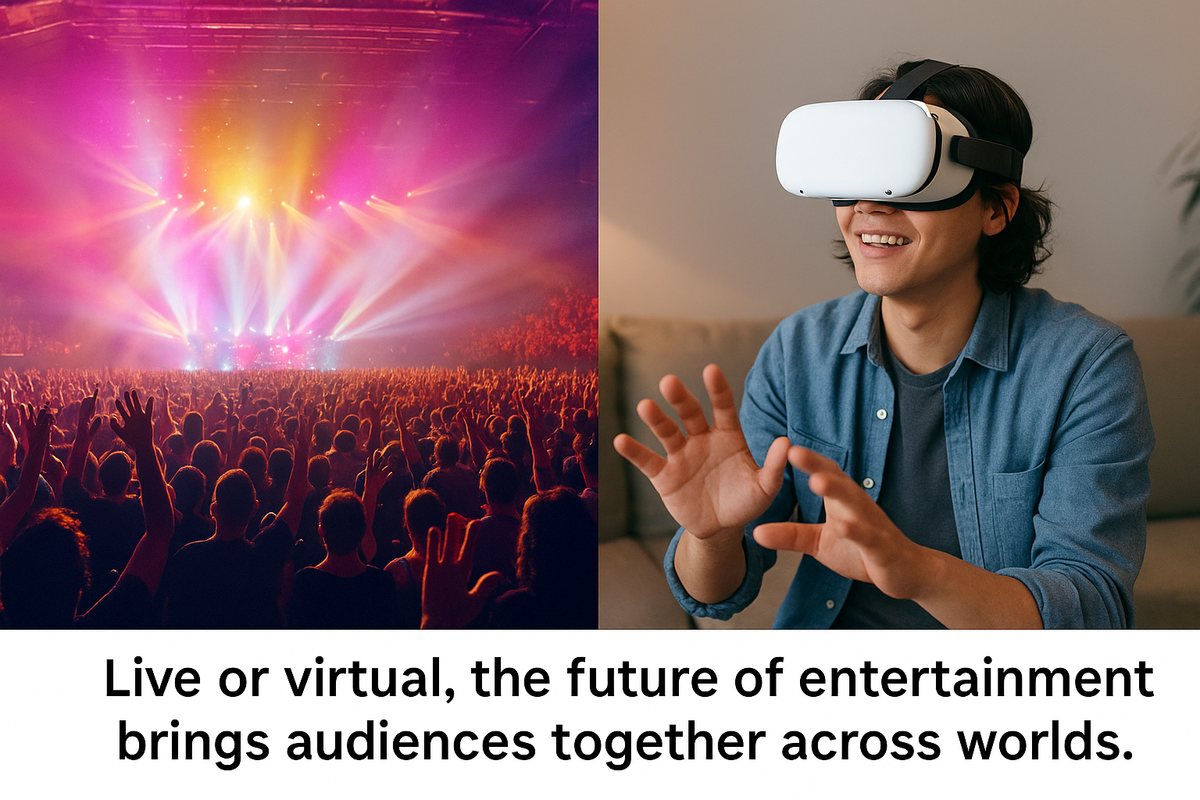Live & Hybrid Entertainment’s Comeback: The Future of Experiences in 2025
Live and hybrid entertainment is making a powerful comeback, blending concerts, theater, and festivals with immersive AR/VR technology, creating global, interactive experiences that connect audiences like never before.

Introduction: The Curtain Rises Again
The world of entertainment is evolving at a pace that feels almost cinematic. After years of disruption caused by the pandemic, digital fatigue, and shifting audience behaviors, live and hybrid entertainment is staging a powerful comeback. Concert arenas are buzzing again, theaters are filled with laughter and applause, and festivals are blending physical excitement with cutting-edge digital layers.
But what’s even more striking is the rise of hybrid experiences a seamless mix of live events and virtual participation powered by AR, VR, holograms, and interactive platforms. In 2025, audiences no longer have to choose between being in the venue or watching from home they can enjoy immersive entertainment that adapts to their lifestyle, location, and budget.
This comeback is not just about entertainment. It’s about human connection, technological innovation, and the redefinition of culture in an era where boundaries are dissolving.
The Return of Live Entertainment
For decades, concerts, theaters, and festivals have served as cultural touchstones, places where people gather to celebrate music, art, and shared experiences. The global lockdowns reminded us of something profound: the irreplaceable energy of being physically present.
- Concerts: Stadium tours are breaking records again, with artists leaning into elaborate stage design, pyrotechnics, and immersive lighting to give fans something streaming platforms never could.
- Theater: Broadway and West End productions are experiencing a renaissance, with audiences hungry for the raw, unfiltered performances that can’t be paused or replayed.
- Festivals: From Coachella to Glastonbury, live festivals have evolved into lifestyle hubs, featuring wellness zones, brand activations, and sustainability-focused setups alongside music.
The demand reflects a deeper truth: people crave collective memory-making. The shared scream when a favorite artist hits the stage, the gasp in a theater audience, the mass sing-along at a festival these are experiences technology alone cannot replicate.
Hybrid Entertainment: Where Physical Meets Digital
While live events are thriving, hybrid formats are expanding the stage to a global audience. Hybrid entertainment isn’t just live-streaming a concert it’s transforming participation itself.

- AR and VR layers: Fans attending a concert in-person may hold up their phones and see digital overlays like dragons flying over the stage or virtual guest performers. Meanwhile, those at home can step into the show using VR headsets, feeling like they’re in the front row.
- Interactive festivals: Hybrid music festivals allow global fans to buy virtual tickets. Through avatar-based worlds, they can walk through virtual festival grounds, meet other fans, and even customize their viewing angle of the main stage.
- Theater with global reach: Plays and musicals are experimenting with “dual stages” an in-person show augmented with a simultaneous digital broadcast enhanced with behind-the-scenes access, alternate camera views, or real-time interactive storytelling.
Hybrid doesn’t replace live; it amplifies it. It ensures fans who cannot physically attend are still part of the magic while offering those in attendance an elevated, layered experience.
Why Audiences Are Flocking Back
The surge in demand for live and hybrid entertainment isn’t random—it’s fueled by cultural and psychological shifts:
- Revenge Entertainment
Much like “revenge travel” post-lockdowns, people are rushing back to entertainment to make up for lost time. There’s a heightened desire to experience more, feel more, and connect more. - Digital Fatigue
After years of back-to-back Zoom calls, passive streaming binges, and endless scrolling, audiences crave real presence. Live entertainment satisfies this craving, while hybrid formats keep convenience intact. - Community Building
Humans are inherently social. Shared entertainment creates bonds, whether it’s singing along at a concert, laughing in a theater, or collectively cheering during a live-streamed hybrid event. - Personalization & Access
Hybrid platforms allow people to tailor experiences whether they want an all-access backstage VR pass, a budget-friendly digital ticket, or a high-end VIP in-person seat. This flexibility broadens the audience base dramatically.
Technology Driving the Hybrid Wave
The fusion of physical and virtual entertainment would be impossible without technological leaps. Here’s how technology is shaping the comeback:
- Extended Reality (XR): Combining AR, VR, and MR, XR offers layered experiences like interactive holograms or 360-degree camera streaming that enrich both in-person and remote participation.
- Holographic Performances: Artists can “tour” globally without leaving one stage, projecting lifelike holograms of themselves across multiple cities. Fans experience a live concert without geographical limitations.
- AI Personalization: AI curates content feeds during hybrid events, recommending what stage to watch, when to switch views, and even translating performances into multiple languages in real time.
- Blockchain & NFTs: Digital tickets double as collectible NFTs, offering perks like exclusive digital content, access to fan clubs, or early invites to future shows.
5G Connectivity: Ultra-fast networks enable seamless, lag-free hybrid streaming, ensuring fans at home feel as close to the action as those in the stadium.

Case Studies: The Big Players Redefining Entertainment
Music Festivals: The Virtual Coachella
Coachella recently experimented with an AR-powered festival app where fans could see virtual art installations and even “meet” avatars of performers. Fans at home used VR headsets to navigate a digital twin of the festival grounds. This dual-layer festival drew millions beyond the desert.
Theater: Broadway Goes Global
Some Broadway productions now sell hybrid tickets. In-person audiences enjoy the live drama, while virtual attendees can toggle between the main performance, backstage camera feeds, or actor interviews mid-show. This has made Broadway more accessible to fans worldwide.
Sports Crossovers
Though sports is not pure entertainment, concerts and shows are learning from hybrid sporting events. For example, hybrid watch parties where fans in different countries gather in VR stadiums are being mirrored by festivals offering global digital fan hubs.
The New Economics of Live & Hybrid Entertainment
The financial dynamics of live and hybrid entertainment are reshaping the industry:
- Diversified Revenue Streams
Beyond ticket sales, organizers now profit from virtual passes, VR experiences, branded digital merchandise, and NFTs. - Tiered Pricing Models
Hybrid allows for tiered pricing: a $20 virtual ticket, a $150 in-person ticket, or a $500 immersive VIP AR package. This inclusivity captures a wider market. - Sponsorship & Brand Activations
Brands love hybrid events they can sponsor physical activations (like lounges or pop-ups) while also embedding themselves into virtual worlds (interactive AR ads, digital skins, or branded VR experiences). - Sustainability Savings
Hybrid reduces travel-related emissions by giving fans a digital option, appealing to eco-conscious consumers while cutting costs for organizers.
Challenges on the Road Ahead
The comeback is powerful, but not without obstacles:
- Technology Barriers: Not all fans have VR headsets or AR-compatible devices, limiting participation.
- Cost of Production: Hybrid events require dual setups live and digital often inflating budgets.
- Digital Inequality: While hybrid makes entertainment accessible globally, regions with poor internet access remain excluded.
- Experience Gap: Virtual fans may feel “less than” compared to in-person attendees unless carefully designed.
- Authenticity Concerns: Critics worry hybrid formats may dilute the intimacy of live performances.
The Future: Where Are We Headed?
Looking ahead, live and hybrid entertainment will evolve beyond novelty into the default mode of cultural experiences.
- Metaverse Venues: Entire concerts or plays hosted in metaverse arenas, accessible to millions simultaneously.
- Hyper-Personalized Hybrids: AI crafting unique experiences for each fan choosing the camera angles, customizing sound, or overlaying digital effects based on preferences.
- Seamless Wearables: Lightweight AR glasses replacing bulky headsets, allowing hybrid experiences to be as natural as looking through spectacles.
Cross-Cultural Integration: Hybrid entertainment will erase geographical and linguistic barriers, allowing global audiences to celebrate art together in real time.

Ultimately, the future isn’t about replacing live with digital it’s about blending them in ways that make entertainment more inclusive, immersive, and unforgettable.
Conclusion: The Stage is Bigger Than Ever
The comeback of live and hybrid entertainment is not just a revival it’s a reinvention. It represents a new era where human connection meets digital possibility, where physical presence is amplified by virtual magic, and where audiences worldwide can be part of the same show, no matter where they are.
Whether you’re standing shoulder-to-shoulder in a buzzing stadium, wearing a headset in your living room, or scrolling through an AR-enhanced festival stream, one thing is clear: entertainment has never been more alive, more hybrid, or more human.
Sources
Industry trend reports, entertainment news coverage, and insights from technology and media analysis informed this article, including updates on live events, hybrid entertainment formats, and AR/VR innovation in 2025.




